Also referred to as the Mastacembelus erythroataenia, the Fire eel is one among the largest eels. Although not a true eel, its features resemble a real eel and it is for this reason that it obtained its name.
Table of Contents
Fire Eel: A Summary
Fire eels, also known as Mastacembelus Erythrotaenia, are a species of freshwater fish native to Southeast Asia. They are popular in aquariums due to their striking appearance, with a long, slender body and bright red markings. Fire eels are carnivorous and should be fed a diet of live or frozen insects and small crustaceans.
Fire Eel Overview
Apart from its snake-like appearance usually associated with eels, it has very little or no resemblance to an actual eel. On its profile are the pointed snout on the face and a long lithe body measuring anything from 60cm to 100cm for a mature fish.
| Information Chart | Fire Eel |
|---|---|
| Family: | Mastacembelidae |
| Lifespan: | 10 years |
| Care Level: | Easy |
| Diet: | Omnivore; bottom feeder |
| Temperament: | Predatory |
| Size: | 20 inches |
| Tank Set-Up: | Freshwater with plants and rocks |
| Compatibility: | Peaceful but predatory |
| Color Form: | Brown with red or orange |
| Minimum Tank Size: | 80 gallons |
Appearance of Fire Eel

The Fire eel has an elongated body. This is covered by scales. On its face are huge protruding eyes. Next to the eyes are posterior nostrils that stand out.
There is an outgrowth on the snout. It is very sensitive and is used to feel the bottom of water for any feeds. Two tabulated nostrils dot the end of the long nose. It is due to the peculiar appearance that this fish was included in the Mastacembelidae family.
The fire eel has a fully developed tail. The pectoral fins as well as the air-bladder are developed too. Another unique feature is the dorsal fin that is divided into two parts. Towards the end of the caudal fin are the dorsal and anal fins. Both are narrow and relatively long.
The fish has a dark brown color on its body. It lacks abdominal fins. Along its profile are four lateral strips. These are orange to bright red in color. Most often, they are dotted with tiny spots and thin lines.
The spots on the fish vary. This mostly depends on tank conditions and age of the fish. Perhaps one of the most unique feature of the fire eel is the red edge on the pectoral, anal and dorsal fins. It can live for ten years or more if taken care of well in captivity. In the wild, it may grow to 3.3ft, and about 20 inches in the aquarium.
Natural Habitat And Origin
The fish is native to the Asian Riverbeds of the South-East. It is mainly found in slow moving muddy lakes and rivers where it buries itself in the mud. Asian countries that house it include Pakistan, Cambodia, Burma, Laos, Indonesia, Malaysia and Vietnam.
For the locals of the regions it is found, it is a preferred delicacy. However, it is known to be aggressive and may easily harm a fisherman who is not careful when getting it out of the net. It has rather sharp spines, though these are not poisonous. Still, plenty of care ought to be taken as the slime produced by spikes contain some level of toxins that may be harmful.
Fire Eels are found in Indonesia, Laos, Vietnam, Cambodia, Pakistan, Burma, Thailand, Malaysia, and other Southeast Asian countries. Their origin and their natural habitat are Southeast Asia. They live in slow-moving rivers and flood plains, and they are bottom-dwellers that like unclean environments.
Types Of Fire Eel
It belongs to the spiny eel family, including Tyre track and Peacock eels. The several tiny dorsal spines that precede the dorsal fin give the group its name.
The Lifespan Of Fire Eel
The lifespan is 10 years and more.
Fire Eel Size
A Fire Eel in your home tank may grow roughly 20 inches (60.8 cm) long and live for around 10 years if given proper care.On the other hand, Fire Eels may grow up to 3.3 feet in their natural habitat.
Fire Eel Care & Tank Set-Up
Fire Eel Optimum Tank size and Specifications
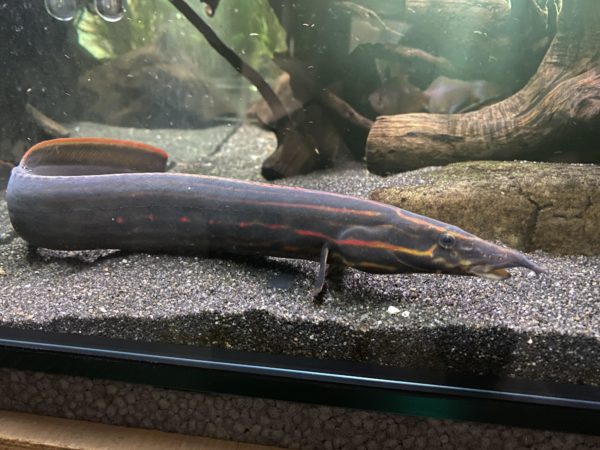
The fish grows immensely after just a while. The following tank conditions would be ideal for it:
- A 80 gallon tank or slightly more than 350 liters.
- A thick substrate of sand, approximately 2 inches (5cm) thick, and fine loam. The edges of the sand should be smooth to avoid scratching its smooth body.
- Provide rocks with sizeable crevices where the fish will hide. Remember it mainly sticks to the mud in its natural habitat. Try to mimic this kind of environment in the tank as well.
- Floating plants to provide a shadow. Rooted plants may not last long as it is a bottom dwelling fish.
- Keep the temperatures at about 25-28C or 74-82F.
- Maintain a pH of between 6.8 and 7.5.
- A water hardness of 15.
- Provide a tight lid over the tank since it uses every opportunity to escape from captivity.
- Provide sufficient aeration.
- Ensure the filter is functioning well to keep the water clean.
- Maintain a continuous water flow.
- Renew the water regularly.
Optimum Tank Size for Fire Eel
A fire eel may grow 50cm/20″ long; thus, a tank with a minimum size of 400 l/88 gallons is recommended.
Optimum Tank Shape
A large rectangular tank is best for Fire Eel habitat.
How many fire eels can be kept together?
Because the fish is hostile to other fish of its species, it should be kept alone in a tank, while it may benefit from the company of other fish in the tank who are both active and quiet.
Filter Type
Fire eels demand a steady supply of well-oxygenated water. Because Fire Eels need very clean water, frequent water changes and a strong filter are required to provide your Fire Eel with the best possible environment.
Substrate
A thick substrate of sand, approximately 2 inches (5cm) thick, and fine loam. The edges of the sand should be smooth to avoid scratches on its smooth body.
Water Parameters for Fire Eel
Water Temperature
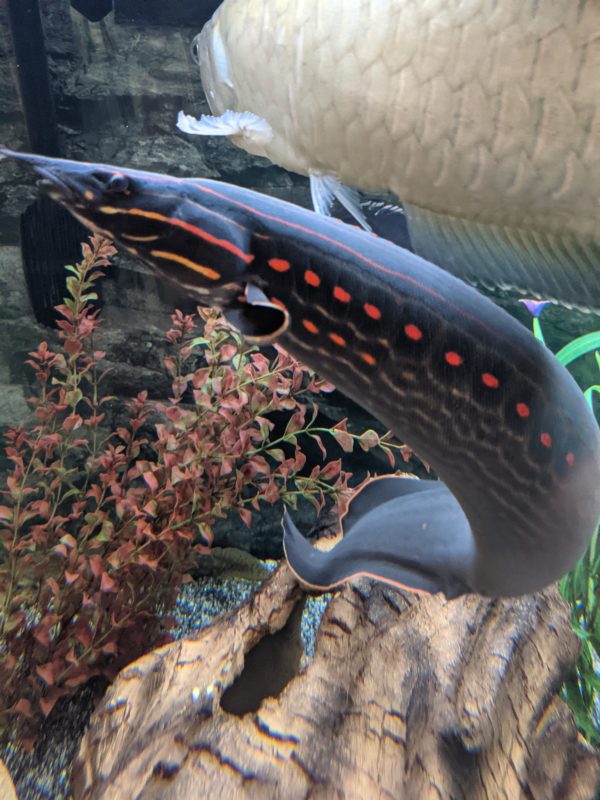
The water should be kept at a temperature of 24-28°C (75-82°F), with a pH of 6.8-7.5 and a hardness of no more than 15°.
Make sure the tank is free of cracks; otherwise, the fire eel will be able to ‘escape’ via the tiniest of breaches.
Ph Level
6.8-7.5
Water Flow Rate
It is critical to have full aeration, filtration, and regular water replenishment while caring for fish. The organism also prefers the presence of some water movement in a tank.
Fire Eel Tank Landscape
These eels will burrow in the sand, just as so many other eels do since they want to be hidden from view. They will feel safer and more at ease if you include some aesthetically attractive décor in your landscape, which will encourage them to come out and play more often.
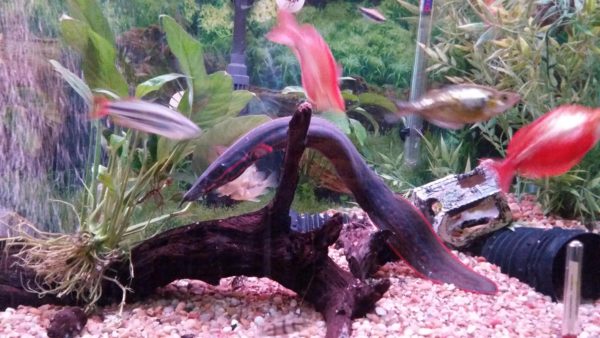
Best Plants for Fire Eel Tanks
Floating plants are the most appropriate for them.
Decorations for Fire Eel Tanks
Tubes, tunnels, and rocks to hide behind will prove exceptionally advantageous to these fearful folks. When it comes to more enormous eels, they still require hiding and searching locations. Tubes and driftwood and appropriate plant life that can endure reduced light levels are fantastic additions to the tank environment.
Lighting for Fire Eel Tanks
They can survive lower lighting conditions.
Feeding Fire Eel
The fire eel begins to recognize its owner after just a short while. Feeding it from the hand often stimulates this. It feeds on both live, dried and frozen foods. To help it grow to maturity quickly, the following should be included in its diet:
- Bloodworm
- Tubifex
- Insect larvae
- Snails
- Worms
- Crabs
- Small fishes
The Fire eel is a predatory fish that hunts for its feeds in the wild. Owing to its size, it also feeds well. It is important to offer it sufficient feeds so that it thrives. Sufficient feeds often leads to a good coloration of the fish and makes it quite active.
Fire Eel Behavior And Temperament
Fire eels are violent when it comes to their king, so having more than one in the same tank is not recommended.
Because fire eels are nocturnal species that like to hide during the day, make sure there are many hiding places. Aquarists should remember that standard decorations, like stones and small aquatic plants, will not be enough for these 20-inch eels, so give them something more solid.
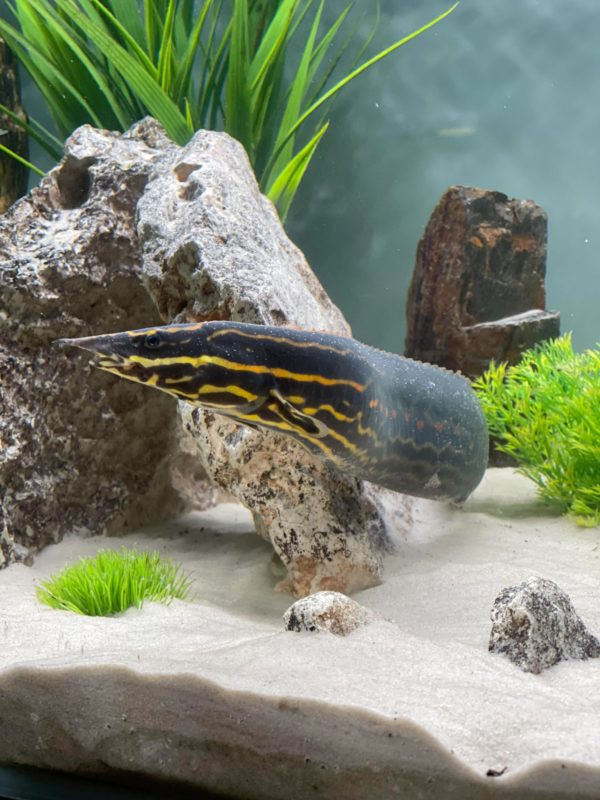
As a favorite hobby while in captivity, they like building tunnels in the muddy bottoms of the tanks where they are housed. It is thus not advisable to maintain plants with roots in the same tanks as these fire eels. The eels need a few minutes to bring them out of the water.
When left alone in the tank, they are incredibly quiet fish that hide beneath the rocks and only come out to eat the food you offer them.
Fire Eel Compatibility and Tank Mates
Fire eel is considered a docile fish that will mostly ignore bigger tank-mates. However, it is a predator and cannot be housed with smaller fish as these may be easily consumed. Best tank-mates should include Oscar fish, Angel fish, Bumblebee Catfish, and Green terror.
The fire eel is a large yet interesting fish for the aquarium. Although it requires a bigger tank as compared to most other fish kinds, it is worth the trouble.
Other huge cichlid species, such as oscar fish, green terror, angelfish, Arowana, bichir, and other tiny cichlid fishes, share a communal tank with it. Despite its appearance as a benign fish, the Fire Eel is a predatory monster. Fire Eels will not disturb fish larger than themselves, but they will prey on fish that are smaller than themselves.
Fire Eels who are compatible with these tank mates.
- Angel Fish
- Barbs (medium to large)
- Green Terror
- Oscar Fish
Breeding Fire Eel
Distinguishing males from females is possible. The female fish is larger while dull colored. On the contrary, the male is slightly trim with a brighter color that gets more heightened during breeding.
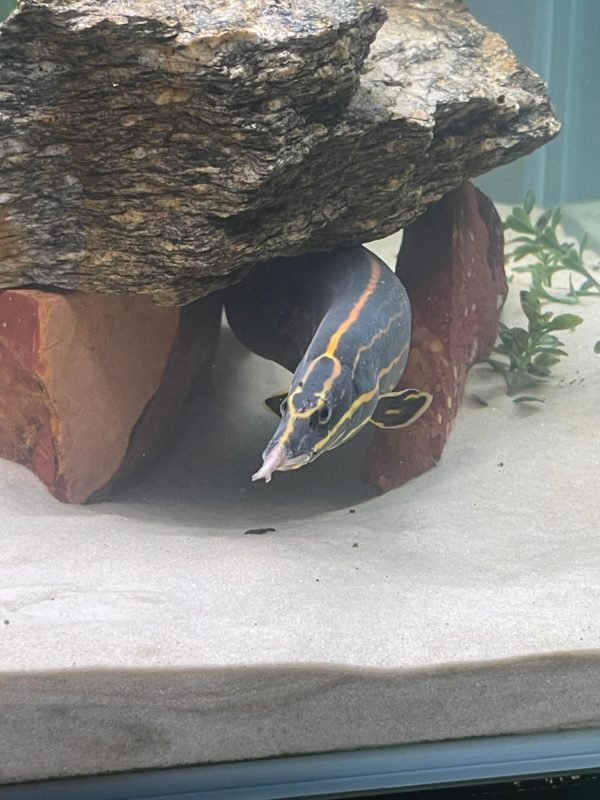
Like most fish in captivity, breeding the fire eel is a gigantic task. Although it is advisable to initiate hormonal injections using special substances, chances of success are usually not very promising. All the same, there is always the desire to try. The following tank conditions are necessary for breeding:
- A 90 or more gallon tank
- Water temperature of between 28 and 29C
- Water hardness of about 10
- A pH of between 7 and 7.2
- Powerful tank aeration
- Sufficient water filtration
- 4 sprayers on all the four corners of the tank
- Proper feeds for the fish. These may include tubifex, insect larvae and bloodworms
After spawning, both the fish are ejected from the tank. Fresh water is added to ensure the environment is right for the eggs and subsequent fry. The light is dimmed. The eggs are hatched a few days later using methylene blue. The fry feed on the yolk sac for the first few days before being introduced to ground brine shrimp. If well fed, the fry grow very quickly and should soon begin to swim actively in the tank.
During Breeding
The male hunts the female, chasing it all over the tank. As soon as it catches up with her, it squeezes eggs out from her. By the time the egg laying process is over, the female should have laid approximately 670 to 1000 eggs or more.
Fire Eel Breeding Level
Hard
Fire Eel Common Diseases And Their Treatment
Keep a lookout for any illnesses your eel could have acquired. You should be aware of any changes in their behavior or body markings. Since it is difficult to treat them once they get unwell, you must do all you can to keep the tanks safe and hygienic to prevent your fire eels from getting ill.
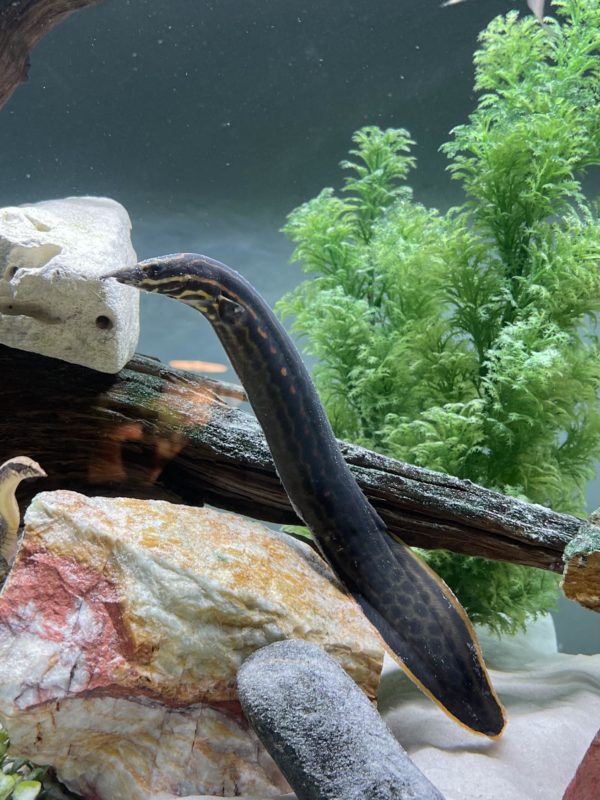
Bacterial illnesses affect fire eels, as do the rest of the spiny eel family. They are quite particular about the water and substrate they live in.
Bacterial infections are a serious threat to your Fire Eels, affecting all spiny eels. Like those that affect other fish, many common freshwater infections may harm your Fire Eel.
White Spot Disease, also known as Ich, is a parasite condition that causes white spots to appear all over an eel’s body. Infections in fire eels may be induced by not utilizing a soft substrate.
This kind of issue may be addressed using drugs accessible from pharmacies. You only need to act quickly and find a good vet for your pet.
Facts About Fire Eel
- The burning eel isn’t a true eel! It’s a long-bodied fish with a distinctive pointed snout and an underslung mouth.
- A Fire eel’s body is compressed laterally and flattens out as it approaches the caudal fin, resulting in an extended tail.
- Young Fire eels have yellow and amber patterns, which fade to a deep red as they mature. A fire eel’s anal, pectoral, and dorsal fins have red edges.
- When submerged in the riverbed, fire eels like displaying their snout.
- They should be kept with tank mates who are large enough.
- The body of a Fire eel bears four bright red or orange lateral stripes, which are made up of spots and short lines in certain instances.
- The fire eel prefers burrowing in the sand, and it’s possible that digging up tank plant roots can injure them.
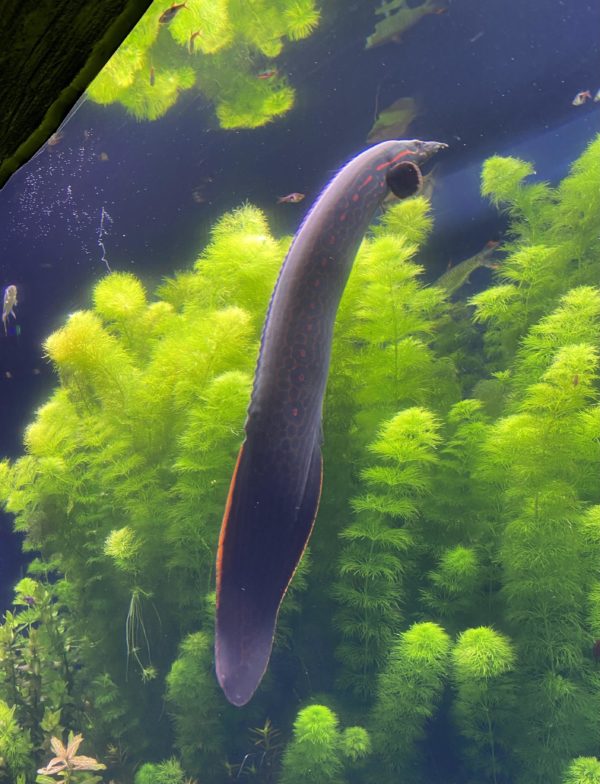
Are Fire Eels Right For You?
The Fire Eels do need a significant amount of area. They may be a rewarding addition to your community aquarium when presented with a challenge, and when they emerge from hiding at night, they create a strong visual effect in the tank.
FAQs
Are Fire Eels Suitable For Your Aquarium?
Fire eels are less demanding in water chemistry than some species that are more reliant on specific environments since they are often found in large lowland rivers. If the water conditions are right and you have a large space that is enough for a Fire eel, then you can easily keep them in your aquarium.
To What Extent Can Fire Eels Grow?
They can reach a maximum size of 80cm/32”. In captivity, fire eels grow at a slow rate of about four to five inches each year.
Are Freshwater Eels Aggressive?
Yes, they can be aggressive sometimes.
What Is The Smallest Freshwater Eel?
This species of spiny eel is among the smallest in the family. A half-banded spiny eel seldom reaches a length of more than 8 inches (20 cm).
How Long Do Freshwater Eels Live?
With adequate care, they may survive for about ten years.
Conclusion
If you have the chance to keep a Fire Eel as a pet in your aquarium, it will be a fantastic companion. However, owing to the sheer size of the fish, maintaining a fire eel fish may be a challenging task. It’s an intriguing animal with a certain level of charm and attraction due to its sleek appearance, but you must feed it good food and keep it in a suitable environment.
